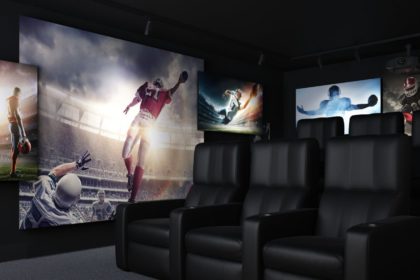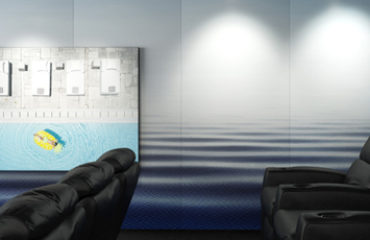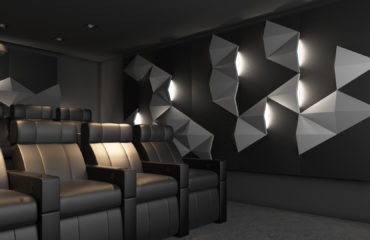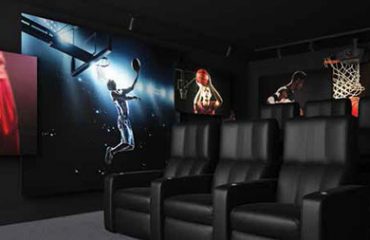
By TecHomeX

THE COMPANY’S TURNKEY INSTALLATION PACKAGE IS REVOLUTIONIZING HOW HOME THEATERS ARE BUILT.

The rise in technology and entertainment options has created a new market for home theaters.
However, they have often been financially out of reach for many home buyers, and builders have been shying away from including them in projects because they lack the return on investment that makes them worthwhile.
But, one company believes it has the solution that offers builders financial incentive, while delivering a high-quality room to the client.
THE EVOLUTION OF THE HOME THEATER

“As a consumer, you have unlimited streaming options,” says Kalomirakis. “You can get anything you want on the screen. A screen you can spend every night with your family.”
Rayva was developed by accident. It was born out of Theo Kalomirakis’s own love of watching movies. In 1985, he bought a brownstone in New York and turned the basement into a small and basic theater room.
As friends told him how impressed they were with it, he sold the house and built a much more elaborate theater in his new home, complete with lobby, marquee and curtain. That’s when the major press came, in the form of articles from the likes of the New York Times, Wall Street Journal and USA Today.
Kalomirakis had a good magazine job, but his boss, Malcolm Forbes, told him opportunity was knocking and he should build another one. His first project was in the Hamptons home of Ron Lauder – the son of Estée Lauder – while he was running for mayor of New York City.
After that project went well, followed by a second, it became clear to Kalomirakis that this was his future. And, in 1990, Rayva was born.
“It became obvious by accident I hit a nerve,” he says. “It’s an accident because I didn’t really develop anything. I just put two and two together.”
MAKING THE PROCESS EASIER
Since the beginning, Rayva’s focus has been on making the home theater defined by more than just its technology. Kalomirakis says he noticed the home theater becoming too much about the specs of the equipment being used, making the charm disappear.
“If you put the emphasis on technology, you lose the fact that home theater is not about amps or lumens,” he says. “It’s about the experience of sitting in a dark room and enjoying, without interruptions, incredible content with great sound and great pictures.”
When clients design their theaters around specs, Kalomirakis says that’s when problems develop. At that point, builders get caught between architects, designers and integrators who all have their own goals, causing headaches that keep them from wanting to include them in projects again in the future.
“At some point, the builders said, ‘to hell with it. This it too complex,’” Kalomirakis says. “It costs more money. We’re just not going to do it.”
His concept was to take the headaches out of home theater-building, while making the rooms make business sense for builders.
THE COMPLETE PACKAGE
Kalomirakis wanted to eliminate the complications typical of building home theaters. So, Rayva specializes in providing all-inclusive installations for builders.

Rayva’s home theater templates come in four different sizes and can be tailored to fit in each home.
The company has developed complete home theater packages in three different categories tailored to each customer’s preference – room size, which prioritizes the number of chairs in the room; room performance, which places an emphasis on the electronics in the room; and room design, which provides the most aesthetically-pleasing look.
The options come in several different templates, ranging in size from 13’ x 16’ to 16’ x 21’, and each can be tailored slightly to fit the exact specifications for an individual project.
“Our principle is similar to what you do when you go to a department store and want to buy a suit that is guaranteed to have good tailoring,” Kalomirakis says. “But, chances are that the suit will fit your body are slim. Usually you have to shorten the sleeves or lengthen the pants, and that’s what we do with the form.
“The templates exist to have the bone structure of the room to be intact, the design on the walls to be what they’re supposed to be, but we kind of tailor the size, the room dimensions slightly — two inches here, three inches there – to make it fit the template that excites the client to buy the room in the first place.”
SMART INVESTMENTS
Traditionally, adding a home theater to a build is an expensive and frustrating process. According to Kalomirakis, a good home theater will cost in excess of $150,000, which is a price point that often doesn’t make financial sense for all but very high-end builders.
So, Rayva found a way to not only make the process easier, but much more affordable. Kalomirakis says attendees at a recent builder show were amazed at what they could do with home theaters for a fraction of the price.
“Those that came into the presentation were wowed,” he says. “They said, ‘I can’t believe we can do that for as little as this room costs and we can get that incredible experience.’”
Ultimately, Kalomirakis says home theaters make sense for builders simply because homes that include them sell better than those without.
IT’S ABOUT EDUCATION
Kalomirakis says the best way to increase the popularity of home theaters now is education. The more builders are able to learn about why these are wise investments, the more likely they are to continue to include them in their projects.
“When you educate [builders] about the advantage of putting something in their house that might make their property more desirable than an exactly similar property next door without a home theater, chances are the builder will become a promoter of your concept,” Kalomirakis says.

“What we try to do is to educate builders about what a weapon for selling a house is to put the theater,” says Kalomirakis.
Meanwhile, educating a consumer is also important. Kalomirakis believes the consumer needs to be educated about the difference in lifestyle of having a theater, which is accomplished much more easily by getting them to see one firsthand rather than just in a brochure.
“Once you sit down a consumer into a chair and you let him experience movies like you’re in a movie theater, they’re sold,” Kalomirakis says. “They’re buying.”
To make that happen, Rayva hopes to soon put theaters in design centers around the country to allow consumers and builders to be able to see the product for themselves.





